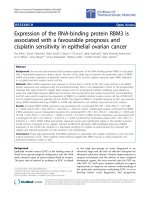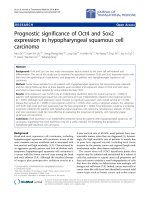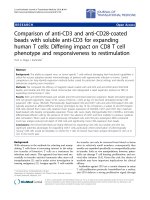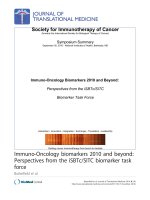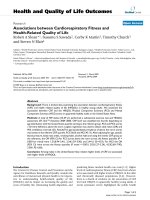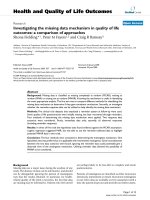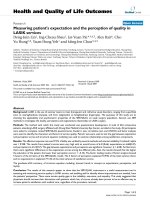Báo cáo hóa học: " Pesticide exposure, risk factors and health problems among cutflower farmers: a cross sectional study Jinky Leilanie Del Prado-Lu" pptx
Bạn đang xem bản rút gọn của tài liệu. Xem và tải ngay bản đầy đủ của tài liệu tại đây (253.8 KB, 8 trang )
BioMed Central
Page 1 of 8
(page number not for citation purposes)
Journal of Occupational Medicine
and Toxicology
Open Access
Research
Pesticide exposure, risk factors and health problems among
cutflower farmers: a cross sectional study
Jinky Leilanie Del Prado-Lu
Address: National Institutes of Health, University of the Philippines, Manila, Philippines
Email: Jinky Leilanie Del Prado-Lu -
Abstract
This was a cross-sectional study which aimed to determine associations between hematologic
indices such as red blood cell cholinesterase (RBC) and mean corpuscular volume (MCV), with
illnesses related to pesticide exposure among cutflower farmers in La Trinidad, Benguet. One
hundred two (102) randomly selected cutflower farmers underwent comprehensive, personal
physical health and laboratory examinations and answered a questionnaire on work practices and
illness. Majority were males (52%) and most belonged to the 20–35 age group (45%). Majority of
exposed farmers were symptomatic, with most common complaints being headache (48%), easy
fatigability (46.1%) and cough (40.2%). Analysis showed that RBC cholinesterase levels were
positively associated with age (p = 0.02), and selling pesticide containers (p = 0.008). number of
years of using pesticides (p = 0.022), use of contaminated cloth (p = 0.033), incorrect mixing of
pesticides (p = 0.041), sex (p = 0.002) and illness due to pesticides (p = 0.005) were correlated with
abnormal MCV. Significant associations were also found for hemoglobin, hematocrit, RBC, white
blood cell (WBC) and platelet count. Predictors of RBC cholinesterase were years of pesticide use
(p = 0.037) and abnormalities on health (p = 0.029). The findings of the study can be used for
information dissemination and pesticide reduction programs for the cutflower farmers.
Background
Agriculture is a basic source of income and subsistence
among many Filipinos. Despite the rise of industrializa-
tion, agriculture remains a highly significant contributor
to the country's Gross Domestic Product. One of the lead-
ing sectors in agriculture in terms of income and growth is
the local cutflower industry. Unknown to many, the Phil-
ippine flower industry provides a significant portion of
earnings derived from agriculture. It has become a lucra-
tive business and much of the country's supply comes
from the flower plantations in La Trinidad, Benguet. This
municipality grows cutflowers like roses, mum, chrysan-
themums, angel's breath and anthorium, accounting for a
billion dollar industry. Due to the steep competition and
large demand, many farmers resort to the extensive use of
pesticides to increase yield.
Pesticide use has been documented to lead to adverse
health effects. Pesticide related health problems usually
manifest as a series of symptoms depending on severity of
exposure. For instance, mild organophosphate poisoning
manifests in the form of malaise, vomiting, nausea,
diarrhea, loose stools, sweating, abdominal pain and sal-
ivation. Moderate poisoning includes dyspnea, decreased
muscular strength, bronchospasm, miosis, muscle fascic-
ulation, tremor, motor incoordination, bradycardia, and
hypotension/hypertension. Severe manifestation could
result in coma, respiratory paralysis, extreme hypersecre-
Published: 18 September 2007
Journal of Occupational Medicine and Toxicology 2007, 2:9 doi:10.1186/1745-6673-2-9
Received: 12 August 2006
Accepted: 18 September 2007
This article is available from: />© 2007 Del Prado-Lu; licensee BioMed Central Ltd.
This is an Open Access article distributed under the terms of the Creative Commons Attribution License ( />),
which permits unrestricted use, distribution, and reproduction in any medium, provided the original work is properly cited.
Journal of Occupational Medicine and Toxicology 2007, 2:9 />Page 2 of 8
(page number not for citation purposes)
tion, cyanosis, sustained hypotension, extreme muscle
weakness, muscular paralysis and convulsion (Iowa State
University, 1995)[1]. Other illnesses associated with pes-
ticide exposure are dermatitis, asthma exacerbation (San-
born, Cole, Abelsohn, Weir, 2002)[2], sensory peripheral
nerve defects, chronic neurobehavioral and motor dys-
function (Miranda, McConnell, Delgado, Cuadra, 2002;,
Miranda, McConnell, Delgado, Cuadra, 2004) [3,4], defi-
cits in verbal abstraction, attention, and memory (Farahat,
Abdelrasoul, Amr, Shebl, 2003)[5], and anxiety and
depression (Jamal, Hansen, Pilkington, Buchanan,
2002)[6]. These effects have been suggested to impair
farmers' ability to comply with established safety proce-
dures (Beseler and Stallones, 2003)[7].
This study aims to determine association between hema-
tologic indices such as RBC cholinesterase and mean cor-
puscular volume (MCV), and illness among cutflower
farmers. This is the first ever data for cutflower farmers in
the Philippines. Biological marker such as monitoring of
serum cholinesterase and cholinesterase enzymes in red
blood cells (RBC) can assess actual exposure to pesticides
particularly organophosphates (Tayser, 2005) [8]. Organ-
ophosphates inhibit the action cholinesterase thus
increasing the cholinergic effects of the neurotransmitter,
acetylcholine in the body and depolarization of neural
transmission (Weiss, Amler S, Amler R, 2004) [9]. Below
50% from the baseline data of serum cholinesterase indi-
cates a significant acute organophosphate toxicity.
Data from this study can be helpful in formulating medi-
cal surveillance for farmers and to improve working con-
ditions in the cutflower industry by formulating an
integrated program on safe and healthy work practices.
Methodology
An initial situational analysis was conducted to investi-
gate the nature and method of pesticide use and applica-
tion which included the brand of pesticide, the active
ingredients, and the concentration of the mixture and the
individual component. A cluster multistage sampling
ter4chniqyue was done. A total of 102 subjects were cho-
sen, with level of significance at P = .05.
The study was cross sectional since all the barangays in La
Trinidad, and the entire province are engaged in either
cutflower or vegetable farming commercially. A compara-
ble control group with pesticide exposure as the variable
would be difficult to identify within the area. The target
area is also much higher in altitude than the rest of Luzon
Island which makes certain physiologic profile of farmers
different. The agricultural crops grown between the low-
land and highland would also be different, and thus,
would have some disparity in terms if pesticide use.
Although cross sectional study is inferior to case control in
identifying the risk factors to health effects, the study tried
to differentiate between exposed (directly) and unexposed
within the same subject population.
Data gathering was done using the following:
1. Questionnaire – Interview with farm workers/farmers
was done. Details included personal information, health
history, pesticide usage, work practices, work conditions,
other risk factors and health data.
2. Exposure assessment monitoring – Blood cholineste-
rase activity was also determined for each farmer of possi-
ble effect of pesticides in the biological system.
3. Individual physical health assessment was done by the
medical doctors who were part of the implementation of
the project.
4. Laboratory examinations, including blood extraction
for RBC cholinesterase levels, complete blood count, and
kidney and liver function tests were done by a licensed
medical technologist. Organophosphate poisoning can be
indicated by a decrease in RBC cholinesterase.
5. Work analysis in each farm to validate work practices
related to pesticide preparation and application.
The specific factors studied in relation to health problems
included pesticide-related symptoms, the categories of ill-
ness refer to symptoms rather than specific illnesses. Acute
symptoms include vomiting, eye irritation, headache,
nausea and allergic reactions. The more chronic symp-
toms include imbalance in gait, tearing of the eye, chronic
dermatitis, neurologic problems, or even cancer. Five (5)
ml of blood was extracted and placed in a heparin tube for
blood cholinesterase determination. An informed con-
sent was given to participants.
The biologic and physiologic correlates of pesticide expo-
sure included blood cholinesterase level, and the symp-
toms and illnesses experience by the respondents. Data
were analyzed using SPSS 10.0
Results and Discussion
a. Socio-demographic profile
Majority of the respondents were males (52%) while 48%
were female. None of the women was pregnant at the tine
of the study. Most belonged to the 20–35 age group
(45%), with ages ranging from 15 to 68 (mean age is 36.4
± 13.09). this shows a population in their middle adult
years. Majority cultivated roses in their farms (36.4%)
while 5% grew mums.
Journal of Occupational Medicine and Toxicology 2007, 2:9 />Page 3 of 8
(page number not for citation purposes)
b. Medical history
Hypertension was the most prevalent illness reported
among the respondents (13%) and their families
(26.4%), followed by allergy (6.7% and 5.3% for
respondents and families respectively) and asthma (3.4%
and 10.1% for respondents and families respectively). Of
380 reported pregnancies, 20 (5.26%) were preterm while
6.3% were abortions. Two cases of congenital anomalies
were also found (Table 1). It has also been found that
infertility is more common in women involved in agricul-
ture and those who live in farms (Fuortes, Clark, Kirchner,
Smith, 1997) [10]. The study of Beam in 2004 [11]
reported that babies born to women with high levels of
pesticides in their blood are lighter than babies who had
not been exposed to the chemicals. In China's rural Anhui
province (Raloff, 2004) [12], it was indicated that at DDT
concentrations present in young women there, the pesti-
cide can affect both menstrual cycles and can cause mis-
carriages in the first few weeks of pregnancy.
Alcohol drinking was common among the respondents
(50.5%) while cigarette smoking was reported by 25.5%
of respondents. Betel chewing was reported by 11.5% of
the respondents. Majority used gas stoves and microwaves
for cooking, while deep well was the predominant water
source (26%). The diet of the farmers consisted mainly of
vegetables (55.8%) followed by seafood (except fish) and
seaweed.
c. Pesticide use
Among the pesticides used, the most toxic and hazardous
is Dithane, which is a category IV pesticide containing
Mancozeb as its active ingredient (Table 2). Dithane has
been used by 35.1% of farmers for approximately 11 years
with the mean usage of 1000 ml per pesticide usage. Tam-
aron is a category II pesticide containing the organophos-
phate Methamidophos and Diethylene glycol, while
Lannate is a category Ib pesticide whose active ingredient
is Methomyl. A study done locally by Baurdoux, Snelder,
De Snoo, in 2004 [13] also found prevalent use of and
easy access to pesticides classified by the WHO as highly
or moderately hazardous and some pesticides tagged for
restricted use by Environmental Protection Agency among
farmers in the Cagayan Valley.
d. Pesticide exposure
Certain behaviors and practices were identified to predis-
posed to pesticide exposure and illness. Twenty percent
(20%) of the farmers used pesticides for more than 20
years and almost 15% have used it for 11–20 years. This is
very significant, and indicates chronic exposure among
these farmers. The farmers were exposed to 30 minutes to
4 hours per day every application, with an average of 3
hours. They are exposed about 1 to 4 days a week or an
average of one and a half days in the application of pesti-
cide.
The activities performed by the farmers while working
with pesticides were loading, applying, and mixing
(76.4%, 77.4% and 76.4% respectively). During these
activities, they are exposed for more than 12 times a year,
which is quite considerable. Incorrect work practices were
also noted among farmers such as re-entering recently
sprayed area (79.3%), wiping sweat off the face (66.8%),
spraying against the wind (23.1), spills at the back
(45.2%) and while spraying (51.9%), loading (29.8%)
and mixing (35.1).
Despite the high risk and frequency of exposure, farmers
did not wear proper personal protection while working
with pesticides. Boots were the only protective equipment
worn by majority of the farmers, and practically no one
used aprons or gauntlet gloves. Cloth face masks which do
not offer adequate coverage for some chemicals were used
by a number of respondents (41%). Improvise forms of
PPE were also used such as handkerchiefs, long sleeves
and plastic pants.
Re-entering a recently sprayed area has been the cause of
a poisoning outbreak in Poland in 2002 after applicators
re-entered a contaminated area before the required safety
period has lapsed. In the same country, 22 poisoning
cases were seen as a result of spraying without adequate
protective gear (Przybylska, 2004) [14]. This shows the
seriousness of the situation faced by the farmers. When it
comes to disposal of pesticide containers, majority
(32.4%) said that they stored used containers in their
Table 1: Medical History of Cutflower Farmers and their Families
(N = 102)
Disease Past History Family History
Percentage Percentage
Hypertension 13.0 26.4
Diabetes mellitus 2.4 5.8
Ischemic heart
disease
3.4 5.8
Kidney disease 2.9 5.3
Asthma 3.4 10.1
Allergy 6.7 5.3
Cancer (leukemia,
osteosarcoma)
1.0 1.9
Endocrine (goiter) 1.0 1.9
Wife's Obstetric
History (N = 380)
Full term 88.4
Preterm 5.26
Abortion 6.3
Congenital
anomalies
Journal of Occupational Medicine and Toxicology 2007, 2:9 />Page 4 of 8
(page number not for citation purposes)
backyard. This is a dangerous practice since household
members may mistake it for another container and reuse
it. Other previously identified risk behaviors for exposure
included frequent pesticide use, washing pesticides equip-
ment in water sources used by humans, inadequate dis-
posal of empty pesticide containers, and eating and
drinking during pesticide application (Hurtig, San Sebas-
tian, Soto, Shingre, 2003) [15].
e. Pesticides and health
e1. Clinical manifestations
A number of respondents (23.5%) reported being ill due
to pesticide use during the last 12 months, with 2.9% hav-
ing constant illness, 3.9% having frequent illness and
16.7% exhibiting occasional symptoms. Among the ill,
only one reported always seeking medical advice in times
of illness, while 7% said that they only consulted occa-
sionally. Onset of illness was reported to be after pesticide
use.
Pesticides have been associated with a number of diseases,
and even death. This was seen by Fleming, Gomez-Martin,
Zheng, Ma, Lee, et al. in 2003 [16], who studied mortality
linked 1986–1994 National Health Interview Survey data.
They found that farmers and pesticide applicators were at
greater risk of accidental mortality compared to all other
workers. Furthermore, both male and female workers had
a higher risk of cancers of the nervous, lymphatic and
hematopoietic systems. Among infants, Young, Eskenazi,
Gladstone, Bradman, Pedersen, Johnson, Barr, Furlong,
Holland, (2005) [17] documented a significant associa-
tion between in utero organophosphate exposure and
abnormal reflexes, which may be associated with subse-
quent impairment of neuropsychological functioning.
Lander and Ronne (1995) [18] also found significant
odds ratio for leukemia among farmers. These point out
the role of pesticides in carcinogenesis and disruption of
hematopoiesis. Genotoxicity has also been linked to pes-
ticides (Undeger & Basaran, 2005; Varona, Cardenas,
Crane, Rocha, Cuervo, Vargas, 2003) [19,20].
General symptoms (weakness, fever, lethargy) were the
predominant abnormal manifestations among those
examined (63.8%). HEENT symptoms (blurring of vision,
deafness, headache) were also predominant among the
farmers. Involvement of the skin was also noted, with
21% of farmers having integumentary abnormalities. Spe-
cifically, headache was the most frequently reported
symptom (48%) closely followed by easy fatigability
(46.1%) and cough (40.2%). Blurring of vision and palpi-
tations were also common (36.3% and 33.3% respec-
tively). Similar symptoms were found by Strong,
Thompson, Coronado, Griffith, Vigoren, Islas, in 2004
[21] among farmers exposed to organophosphates.
On physical examination, 90 or 88.2% of those examined
were found to have abnormal peak expiratory flow rate
(PEFR). Eighty two percent had abnormal temperature,
followed by abnormal health findings (e.g. cardiorespira-
tory distress). Forty one percent were also found to have
elevated blood pressures (Table 3). Such a constellation of
symptoms are consistent with previous findings of
increased likelihood of chronic disability, health condi-
tions, and poor health among pesticide applicators
(NPCIS, 2004) [22].
e2. Laboratory examinations
Cholinesterase actually corresponds to two enzymes –
acetylcholinesterase and butyrylcholinesterase (also
called plasma cholinesterase) (Hernandez, Gomez, Pena,
Gil, Rodrigo, Villanueva, Pla, 2004) [23]. The activity of
cholinesterase enzymes in the blood can be utilized as a
biomarker for the effect of organophosphates. An exposed
person will show abnormally low levels of activity of
cholinesterase enzymes measured in the serum or in red
blood cells (as RBC cholinesterase). The latter is more
closely correlated with cholinesterase activity in the nerv-
ous system (Tinoco-Ojanguren & Halperin, 1998) [24].
It should be noted, however, that RBC cholinesterase is
more difficult to measure and is depressed more slowly
Table 2: Number of Cutflower Farmers using Certain Pesticides and Quantity Used (in Volume); N = 102*
Brand Name of
Pesticide
Generic Name of
Pesticide
WHO
Category
Number** Percentage Mean number of
years
Mean amount
used (mL)
Tamaron Metaldehyde II 42 20.2 17.11 106.92
Lannate Methiocarb Ib 72 34.6 11.67 347.35
Dithane Mancozeb IV 73 35.1 11.16 1,185.6
Selecron Profenofos III 64 30.8 9.13 136.40
Agrimix Avermectin II 47 22.6 7.01 251.67
Matador Methamidophos Ib 25 12.0 7.96 66.92
Basudin Diazinon II 15 7.2 7.93 557.67
Karate Lambdacyhalothrin IV 12 5.8 6.92 290.42
* Respondents had multiple answers
** Number refers here for the number of cut flower farmers who used this kind of pesticide.
Journal of Occupational Medicine and Toxicology 2007, 2:9 />Page 5 of 8
(page number not for citation purposes)
than plasma cholinesterase. Certain pesticides also exhibit
preferential inhibition of either enzyme. Hence, levels of
both enzymes should be determined to accurately deter-
mine pesticide exposure (Boiko, Keifer, Furman,
Weyrauch, Hanks, 2005) [25].
In Sitio Sadag, 51% had cholinesterase levels below the
mean value of 0.75–1.0 ∆ ph/hour, and 25.5% exhibited
more than 10% depression in the level of RBC cholineste-
rase. Tinoco-Ojanguren and Halperin in 1998 [24] also
found similar lowering of cholinesterase values among
agricultural peasants. Ceratin hematological parameters
wee also abnormal, namely hemoglobin, hematocrit, and
eosinophil count. These laboratory findings are similar to
those found by Svoboda [26] in 2001. The liver (ASL and
LAT) and kidney function test (creatinine) were all nor-
mal for the respondents (Table 4).
f. Chi square test of independence
After performing chi-square analysis to test for independ-
ence, significant association was found between selling
pesticide containers and abnormal RBC cholinesterase
levels (P = 0.001), and mixing of pesticides with abnormal
mean corpuscular volume (MCV) (Table 5).
Cholinesterase measurements also have limitations, since
the rate of enzyme inhibition and subsequent recovery
may differ with exposure to varying organophosphates.
Cholinesterase levels are also affected by inter- and intra-
individual variability (Tinoco-Ojanguren and Halperin,
1998) [24]. Therefore, pre-exposure baseline levels should
be established for each individual so that meaningful
changes in cholinesterase levels may be detected (Hernan-
dez, Gomez, Pena, Gil, Rodrigo, Villanueva, Pla, 2004)
[23].
Table 4: Frequency distribution of Abnormal Laboratory Examination Results of Cutflower Farmers
Abnormal Results
Laboratory Examination Normal Values Number Percentage
Hemoglobin 120–180 g/L 16 15.7
White blood cell count 4–11 × 109 g/L 35 34.3
Hematocrit 0.370–0.540 22 21.6
Platelet count 150–450 × 109 g/L 4 3.9
Aspartate Transaminate (AST) 15–37 units/L 13 12.7
Analine Transaminate (ALT) 30–65 units/L 25 24.5
Creatine 53–155 umols/L 21 20.6
RBC Cholinesterase ∆ ph/hour 0.75–1.0 ph/hour 52 51.0
% Depression of RBC
Cholinesterase
0.75–1.0 ∆ ph/hour 26 25.5
Table 3: Frequency Distribution of Abnormal Physical Examination among Cutflower Farmers (N = 102)
Abnormal Physical Examination Normal Values/Normal Indices Number Percentage
Peak expiratory flow rate (PEFR) Obstructive or restricted lungs using spirometry;
difficulty in respiration
90 88.2
Temperature Not within 36.5–37.5 degrees C 84 82.4
Throat Abnormal growths or lumps 59 57.8
Extremities Abnormal growth or lumps 50 49.0
Blood pressure Not within 120/80 mmHg for females; 90/60 for
females
42 41.2
Eyes Abnormal growths or lumps, redness and tearing of
the eye
37 36.3
Head Abnormal growth or lumps 27 26.5
Ears Abnormal growth or lumps 17 16.7
Neck Abnormal growth or lumps 17 16.7
Heart rate 600–100 beats per minute 16 15.7
Lungs Abnormal growth or lumps 4 3.9
Heart Abnormal murmurs and sounds with stethoscope 2 2.0
Abdomen Abnormal growth or lumps 2 2.0
Nose Abnormal growth or lumps, clogging, inflammation 1 1.0
Journal of Occupational Medicine and Toxicology 2007, 2:9 />Page 6 of 8
(page number not for citation purposes)
In addition, certain conditions other than pesticide expo-
sure can lower plasma and RBC cholinesterase levels, con-
founding interpretation of test results. The former can be
decreased by liver disease, malnutrition, alcoholism,
nephritic syndrome, early pregnancy, contraceptive pills,
and metoclopramide. Meanwhile, RBC cholinesterase lev-
els are lowered by hemolytic and pernicious anemia,
recovery from hemorrhage, and reticulocytosis. Other fac-
tors that may result in false cholinesterase levels are collec-
tion, shipping and laboratory errors, and poor record
keeping and organization (Boiko, Keifer, Furman,
Weyrauch, Hanks, 2005) [25].
Many other hematologic changes secondary to acute and
chronic pesticide exposure have been documented in
both humans and animals, although there are some con-
flicting results (Meaklim, Yang, Drummer, Killalea,
Staikos, Horomidis, Rutherford, Ioannides-Demos, Lim,
McLean, McNeil, 2003; Saly, Kacmar, Neuschl, Jan-
tosoovic, 1995) [27,28]. Pesticides have been shown to
have hematotoxic properties and may cause aplastic ane-
mia, agranulocytosis, neutropenia, and thrombopenia
(Parent-Massin & Thouvenot, 1993) [29]. In rats, Fujitani,
Tada, Yoneyama, (2004) [30] found that sub-chronic
exposure to chlopropham induced dose-dependent,
although reversible methemoglobinemia, anemia,
splenomegaly and pathological lesions indicating hemo-
lytic anemia. Irreversible changes were increased hemosi-
derin deposition and splenic capsular fibrosis. Far more
serious and long-term consequences have been seen in
humans by Khristeva and Mirchev in 1993 [31]. They
found that both acute and chronic exposure to toxic doses
of pesticides as well as drugs and heavy metals may induce
hematologic congenital abnormalities, particularly G6PD
deficiency and thalassemia.
g. Linear regression analysis
There is a significant positive relationship using linear
regression between age and abnormal RBC cholinesterase
levels (p = 0.020). An even more significant association
was found between abnormal RBC cholinesterase levels
and selling pesticide containers (p = 0.008). This is prob-
ably because farmers often clean the containers before
selling them, thereby exposing themselves to residues
present in the containers.
Meanwhile, five variables were significantly correlated
with abnormal mean corpuscular volume (MCV). There
were the number of years of using pesticides (p = 0.022),
improper mixing of pesticides (p = 0.041) and sex (male
farmers tended to have a higher MCV at p-0.002), use of
contaminated cloth (p = 0.033) and illness due to pesti-
cides (p = 0.005). See Table 6.
For abnormal hemoglobin levels (Hgb), significant corre-
lations were found for number of years using pesticides (p
= 0.017), not consulting a doctor when sick (p = 0,025),
abnormal respiratory rate and sex, indicating that male
farmers have higher abnormal Hgb level, and abnormal
blood pressure (p = 0.008). Changes in hemoglobin levels
as well as electrocardiograms have been previously associ-
ated with early hexachlorocyclohexane exposure (Srivas-
tava, Gupta, Bihari, Mathur, Pangtey, Bharti, 1995) [32].
See Table 6. A similar association between RBC count and
pesticide use was also reported with hexachlorocyclohex-
ane by Shouche and Rathore in 1997 [33].
Table 7 shows the predictors of abnormal RBC cholineste-
rase levels and abnormal MCV as dependent variables.
The number of years of pesticide use was found to be a
highly significant predictor of MCV (p = 0.001). Other
predictors are number of hours of pesticide exposure (p =
0.025), sex (p = 0.040) and RBC count (= 0.039). Women
usually have lower MCVs than men because they regularly
shed blood due to menstruation. Meanwhile, MCV is an
index of RBC count, therefore a lower RBC count would
result in lower MCVs. Since we have already accounted for
possible normal physiological explanations for these
results, it seems that pesticide exposure, in particular the
Table 7: Predictors of Abnormal Red Blood Cell (RBC)
Cholinesterase Levels of the Cutflower Farmers
Risk Factors Beta Coefficient Significance
Years using pesticides 2.146 0.037
Abnormal respiratory rate 1.228 0.079
Abnormal health symptoms 6.22 0.029
Table 5: Chi-Square Association between Incorrect Work
Practices and Abnormal Laboratory Findings (RBC
Cholinesterase and Mean Copuscular Volume) (N = 102)
Abnormal RBC
Cholinesterase
Abnormal Mean
Copuscular
Volume
Reuses container to
store other things
3.504 (0.061) 35.306 (0.083)
Sells the container 10.829 (0.001)
Mixing of pesticides 40.549 (0.05)
Table 6: Predictors of Abnormal Mean Copuscular Volume
(MCV) of the Cutflower Farmers (N = 102)
Risk Factors Beta Coefficient Significance
Years using pesticides 0.244 0.001
Hours of exposure 0.434 0.025
Sex 4.409 0.040
Abnormal blood pressure 2.139 0.221
Abnormal RBC count 5.328 0.039
Journal of Occupational Medicine and Toxicology 2007, 2:9 />Page 7 of 8
(page number not for citation purposes)
length of exposure, is a highly significant predictor of
MCV levels. Similar studies, like that of Casale, Scott,
Anderson, JR., Vitzthum, Gold, [34], have found that pes-
ticide use is a significant predictor of RBC count and
hematocrit and that extensive use of pesticides signifi-
cantly reduces serum complement activity.
As for RBC cholinesterase (Table 7), the significant predic-
tors are, again, years of pesticide use (p = 0.037) and
health symptoms reported in the survey (p = 0.029). the
number of years using pesticides gives an index of the
length and possible extent of exposure, which has been
shown to lower RBC cholinesterase levels. Health symp-
toms included in the survey were non-specific such as
drowsiness, and may be attributed to a number of condi-
tions. This makes the detection of pesticide exposure/poi-
soning very difficult since no distinctive or specific
symptom is predictive of the event. Further elucidation of
clinical manifestations that may be used as predictors of
pesticide exposure must be conducted for early and easy
detection of possible poisoning. Moreover, differentiation
must be made between acute and chronic exposures.
Conclusion
The study has demonstrated the detrimental effect of pes-
ticide exposure on RBC cholinesterase levels and the asso-
ciation of various hematologic indices with risk factors
and measures of pesticide exposure. Abnormal RBC
cholinesterase levels were positively associated with age
(p = 0.020), and selling pesticide containers (p = 0.008),
number of years of using pesticides (p = 0.022), use of
contaminated cloth (p = 0.033), and illness due to pesti-
cides (p = 0.005), improper mixing of pesticides (p =
0.041), and sex (p = 0.002). Significant associations were
also found for hemoglobin, hematocrit, RBC, WBC and
platelet count. Furthermore, number of years of pesticide
use (p = 0.000), hours of pesticide exposure (p = 0.025),
sex (p = 0.040), and lowered RBC count (p = 0.039) were
found to be predictors of abnormal MCV. Predictors for
RBC cholinesterase, are years of pesticide use (p = 0.037)
and abnormalities on general survey (p = 0.029).
These findings are further proof of the hematoxic effects of
pesticide exposure. The risk factors and work behaviors
identified in this study could be utilized as a target for
modification and improvement of safety practices among
cutflower farmers who significantly contribute to the
country's growth. A more in depth study is needed to dif-
ferentiate between acute and chronic effects. It will also be
worthwhile to look into specific hematopoietic effects of
pesticide use since these have implications for cancer
development and possible prevention.
References
1. Iowa State University: Safe farm:promoting agricultural health
and safety. 1995.
2. Sanborn MD, Cole D, Abelsohn A, Weir E: Identifying and man-
aging adverse environmental health effects of pesticides.
CAMJ 166:1431.
3. Miranda J, McConnell R, Delgado E, Cuadra R: Tactile vibration
threshold after acute poisonings with organophosphate
insecticides. International Journal of Occupational and Environmental
Health 2002, 8:212.
4. Miranda J, McConnell R, Wessling C, Cuadra R: Muscular strength
and vibration threshold during two years after acute poison-
ing with organophosphate insecticides. Occupational and Envi-
ronmental Medicine 2004, 61:4.
5. Farahat TM, Abdelrasoul GM, Amr MM, Shebl MM: Neurobehav-
ioural effects among workers occupationally exposed to
organophosphorous pesticides. Occupational and Environmental
Medicine 2003, 60:279.
6. Jamal GA, Hansen S, Pilkington A, Buchanan D: Neurological, neu-
rophysical and neuropsychological study of sheep farmers
and dippers exposed to organophosphate. Occupational and
Environmental Medicine 2002, 59:434.
7. Beseler C, Stallones L: safety practices, neurological symptoms,
and pesticide poisoning. Journal of Occupational and Environmental
Medicine. Baltimore 2003, 45:1079.
8. Tayser Abu Mourad: Adverse Impact of Insecticides on Health
of Palestinian farm workers in the Gaza strip: a hematologic
biomarker study. International Journal of Occupational and Environ-
mental Health 2005, 11(2):144,6.
9. Weiss B, Amler S, Amler RW: Pesticides. Pediatrics 2004,
113(4):1030,7.
10. Fuortes L, Clark MK, Kirchner ML, Smith EM: Association between
female infertility and agricultural work history. American Jour-
nal of Industrial Medicine 1997, 31(4):445-51.
11. Beam S: Pesticides Linked with Birth Weight. Environment.
Washington 2004, 46(5):8.
12. Raloff J: DDT linked to miscarriages. Science News. Washington
166(20):318. Nov 13, 2004
13. Baurdoux M, Snelder D, De Snoo G: Pesticides in the Cagayan
Valley (Philippines): usage, drift patters and exposure of
farmers differing in income and market access. Community
Agriculture and applied Biological Science 2004, 69(4):765-78.
14. Przybylska A: Poisoning caused by chemicals for plant protec-
tion in Poland in 2002. Przegl Epidemiology 2004, 58(1):111-21.
15. Hurtig AK, San Sebastian Soto A, Shingre A: Pesticide use among
farmers in the Amazon basin of Ecuador. Archives of Environ-
mental Health 2003, 58:223.
16. Fleming LE, Gomez-Martin O, Zheng D, Ma F, Lee D: National
Health Interview Survey mortality among US farmers and
pesticide applicators. American Journal of Industrial Medicine 2003,
43(2):227-33.
17. Young JG, Eskenazi B, Gladstone EA, Bradman A, Pedersen L, Johnson
C, Barr DB, Furlong CE, Holland NT: Association between in
utero organophosphate pesticide exposure and abnormal
reflexes in neonates. Neurotoxicology 2005, 26(2):199-209.
18. Lander F, Ronne M: Frequency of sister chromatid exchange
and hematological effects in pesticide-exposed greenhouse
sprayers. Scandinavian Journal of Work and Environmental Health
1995, 21(4):283-8.
19. Undeger U, Basaran N: Effects of pesticides on human periph-
eral lymphocytes in vitro: introduction of DNA damage.
Archives of Toxicology 2005, 79(3):169-76.
20. Varona M, Cardenas O, Crane C, Rocha S, Cuervo G, Vargas J:
cytogenic alterations in field workers routinely exposed to
pesticides in Bogota farms. Biomedica 2003, 23(2):141-52.
21. Strong LL, Thompson B, Coronado GD, Griffith WC, Vigoren EM,
Islas I: Health symptoms and exposure to organophosphate
pesticides in farmworkers. American Journal of Industrial Medicine
2004, 46(6):599-606.
22. National Pesticide Information Center: Biomarkers of exposure:
Organophosphates (Medical Case Profile). 2004.
23. Hernandez A, Gomez MA, Pena G, Gil F, Rodrigo L, Villanueva E, Pla
A: Effect of long-term exposure to pesticides on plasma ste-
rases from plastic greenhouse workers. Journal of Toxicology and
Environmental Health 2004, A67(14):1095-108.
24. Tinoco-Ojanguren R, Halperin DC: Poverty, production, and
health: inhibition of erythrocyte cholinesterase via occupa-
tional exposure to organophosphate insecticides in Chiapas,
Mexico. Archives of Environmental Health 1998, 53(1):29-35.
Publish with BioMed Central and every
scientist can read your work free of charge
"BioMed Central will be the most significant development for
disseminating the results of biomedical research in our lifetime."
Sir Paul Nurse, Cancer Research UK
Your research papers will be:
available free of charge to the entire biomedical community
peer reviewed and published immediately upon acceptance
cited in PubMed and archived on PubMed Central
yours — you keep the copyright
Submit your manuscript here:
/>BioMedcentral
Journal of Occupational Medicine and Toxicology 2007, 2:9 />Page 8 of 8
(page number not for citation purposes)
25. Boiko P, Keifer M, Furman J, Weyrauch K, Hanks C: Cholinesterase
Monitoring for Agricultural Pesticide Handlers:. Guidelines for
Health Care Providers in Washington State 2005.
26. Svoboda M, Luskova V, Drastochovai J, Ilabek V: The Effect of
Diazinon on Haematological Indices of Common Carp
(Cyprinus carpio L. Acta Vet Brno 2001, 70:457-465.
27. Meaklim J, Yang J, Drummer OH, Killalea S, Staikos V, Horomidis S,
Rutherford D, Ioannides-Demos LL, Lim S, McLean AJ, McNeil JJ:
Fenitrothion: toxicokinetics and toxicologic evaluation in
human volunteers. Environmental Health Perspectives 2003,
111(3):305-8.
28. Saly J, Kacmar P, Neuschl J, Jantosoovic J: The effect of bentazone
TP, an herbicide, on hematologic indicators in sheep during
acute and subchronic poisoning. Veterinary Medicine (Praha) 1995,
40(2):49-52.
29. Parent-Massin D, Thouvenot D: In vitro study of pesticide hema-
totoxicity in human and rat progenitor. Journal Pharmacological
and Toxicological Methods 1993, 30(4):203-7.
30. Fujitani T, Tada Y, Yoneyama M: Chlorpropham-induced spleno-
toxicity and its recovery in rats. FoodChemical Toxicoly 2004,
42(9):1469-77.
31. Khristeva V, Mirchev N: Changes in the blood system under
chronic toxic pressure. Probl Khig 1993, 18:97-105.
32. Srivastava AK, Gupta BN, Bihari V, Mathur N, Pangtey BS, Bharti RS:
Chronic effects of hexachlorocyclohexane exposure: clinical,
hematological and electrocardiographic studies. Vet Human
Toxiclogy 1995, 37(4):302-5.
33. Shouche S, Rathore HS: Haematological effects of hexachloro-
cyclohexane (HCH) in mice – results and possibilities. Indian
Journal of Medical Science 1997, 51(4):120-2.
34. Casale GP, Scott DM, Anderson JR, Vitzthum EF, Gold RE: A prelim-
inary study of immunologic and hematologic profiles of
peripheral blood from Nebraska farmers who apply pesti-
cides to their fields. Journal of Toxicology and Clinical Toxicology 1998,
36(3):183-94.


